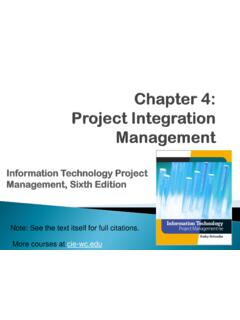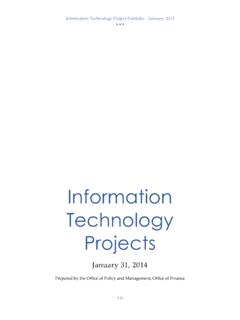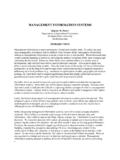Transcription of Planning an information systems project
1 A TOOLKIT FOR PUBLIC HEALTH MANAGERSP lanning an information systems projectTHIS DOCUMENT WAS COMMISSIONED BY OPTIMIZE: IMMUNIZATION systems AND TECHNOLOGIES FOR TOMORROW, a collaboration between the World Health Organization and PATH. The report was authored by Jan Grevendonk, Brian Taliesin, and Dan Brigden of information :Jan GrevendonkTechnical Officer, TaliesinTechnical Officer, Health OrganizationAvenue Appia 20 1211 Geneva, Box 900922 Seattle, WA 98109 USAS treet2201 Westlake Avenue, Suite 200 Seattle, WA 98121 Health Organization, PATH.
2 Planning an information systems project : A Toolkit for Public Health Managers. Seattle: PATH; photo: Joint Learning Network for Universal Health Coverage/Buddy GanzoneOptimize worked directly with national governments and other institutions to identify problems in the supply chain and test innovative solutions. We also worked with vaccine manufacturers and policymakers to help ensure that new products and policies enable supply chain systems to function effectively. The goal was to help define an ideal vaccine supply chain that can be used to develop stronger, more adaptable, and more efficient logistics systems , extending the reach of lifesaving health technologies to people around the more information , please visit the Optimize.
3 project OPTIMIZEP roject Optimize, a five-year partnership between the World Health Organization (WHO) and PATH, was established to identify ways in which supply chains can be optimized to meet the demands of an increasingly large and costly portfolio of vaccines. This work was funded in whole or part by a grant from the Bill & Melinda Gates Foundation. The views expressed herein are solely those of the authors and do not necessarily reflect the views of the 2013 World Health Organization (WHO), Program for Appropriate technology in Health (PATH).
4 All rights reserved. The material in this document may be freely used for educational or noncommercial purposes, provided that the material is accompanied by an authors would like to thank all the people who provided valuable feedback during the creation of this guide. In particular: Anup Akkihal, Thomas Cherian, Marta Gacic-Dobo, Andrew Garnett, Skye Gilbert, Ajay Goel, Heidi Lasher, David Lubinski, Henry Mwanyika, Sophie Newland, Liz Peloso, Kathleen Tiffay, Maeve Wagner, Allen Wilcox, Kate : Rebecca Richards-DiopThis toolkit can help public health managers to plan for the implementation of information and communications technology (ICT) in health information systems .
5 It draws on lessons learned during project Optimize, a five-year partnership between the World Health Organization and PATH to help optimize the vaccine supply toolkit focuses on the Planning phase of an information systems project . It proposes an eight-step process that can help decision-makers: Choose the solution that best fits their needs and context. Obtain the external help and expertise they need. Develop, scale, and then sustain their chosen document describes each step and includes Planning tools to help you complete them.
6 It is not an exhaustive technical guide to implementing information systems , however, and it does not address the strategic questions around a wider electronic health vision. Managers looking for more detailed guidance should refer to Finding more information on page 27 for additional suggested resources in these health information systems use a variety of technologies that can include paper-based tools as well as ICT. In many cases, introducing new information technology presents the best opportunity to improve these systems .
7 However, doing so also poses considerable challenges. This toolkit can help managers to meet these challenges by carefully Planning their use of ICT. There are eight steps in the process of Planning an information systems project :ABOUT THIS E F I N E O R M YOUR E F I N E W H A T YOUR SYSTEM NEEDS TO THE RIGHT E L E C T T H E RIGHT IMPLEMENTATION AND OPERATING R E A T E A N IMPLEMENTATION AND MANAGE project RISKSS hould you buy or build your system? Do you select an open-source or proprietary system?
8 How do you evaluate different systems and select the best one?How do you make sure you select the best providers of technical services?What can go wrong and how can you plan for that?How will a better information system benefit you? How should you define the scope? How will you measure success?What skills and roles are required to bring your project to a satisfying outcome?How can you define your requirements for the system?How much will your project cost to pilot, scale, and maintain?How long will it take to develop, pilot, and scale up?
9 Planning AN information systems project TOOLKITPAGE iiiTABLE OF CONTENTSA cknowledgments ..iAbout this toolkit.. iiAcronyms ..ivIntroduction: Why do so many health information systems fail? ..ivSTEP 1. Define outcomes .. 1 STEP 2. Form your team .. 5 STEP 3. Define what your system needs to do.. 8 STEP 4. Find the right solution .. 13 STEP 5. Select the right vendors ..17 STEP 6. Estimate implementation and operating costs ..19 STEP 7. Create an implementation plan ..21 STEP 8. Understand and manage project risks.
10 23 Finding more information .. 27 Annex 1. project charter .. 28 Annex 2. project roles and responsibilities matrix .. 29 Annex 3. Nonfunctional requirements checklist.. 30 Annex 4. Selection matrix .. 32 Annex 5. Governance and design principles .. 33 Annex 6. Proposal scoring matrix for the selection of a software developer .. 34 Annex 7. Vendor questions .. 35 Annex 8. What drives costs in all phases of the project lifecycle? .. 36 Annex 9. Total cost of ownership budget matrix .. 37 Annex 10. Work plan.



















